"Fire arc". Day of the defeat of the German troops by the Soviet troops in the Battle of Kursk
Situation at the front
In 1943, the war developed under the sign of a radical change on the Soviet-German strategic front. Defeats in the battles for Moscow and Stalingrad significantly undermined the power of the Wehrmacht and its political prestige in the eyes of allies and opponents. At a meeting at the rate of the Wehrmacht 1 February 1943, being impressed by the outcome of the Battle of Stalingrad, Hitler said pessimistically: “The possibility of ending the war in the East through an offensive no longer exists. We must be clear about this. ”
However, having received a hard lesson on the Eastern Front, the military and political leadership of the Third Reich did not look for a way out other than to continue the war. In Berlin, they hoped that there would be some kind of change on the world stage, which would allow us to maintain our position in Europe. There is an opinion that Berlin had a secret agreement with London, so the Anglo-Saxons until the last moment delayed the opening of a second front in Europe. As a result, Hitler could still concentrate all his forces on the Russian front, hoping for a favorable outcome in the struggle against the Soviet Union. I must say that the top of the Reich until the very last moment believed and hoped that the USSR would quarrel with Britain and the USA. And this will allow the German Empire to maintain at least some of the positions.
The Germans did not consider the war against the USSR to be completely lost, and there were even greater forces and means to continue it. The German armed forces retained enormous combat potential and continued to receive the latest weapons, almost all of Europe was under German rule, and the remaining neutral countries in Europe actively supported the Third Reich economically. In February - March 1943, German troops under the command of Manstein made the first attempt to take revenge for the defeat on the Volga. The German command threw large forces into the counterattack, including large masses tanks. At the same time, Soviet troops in the southwestern direction were greatly weakened in previous battles, and their communications were greatly extended. As a result, the Germans were again able to capture Kharkov, Belgorod and the northeastern regions of Donbass just liberated by Soviet troops. The movement of the Red Army to the Dnieper was stopped.
However, the success of the Wehrmacht were limited. Arranging the Russian “German Stalingrad” - Manstein failed to break through to Kursk and surround considerable masses of Soviet troops of the Central and Voronezh fronts. The Red Army, although it had lost a number of areas that had just been liberated, but repelled the blows of the enemy. The strategic situation on the Soviet-German front has not changed. The Red Army retained the initiative and could go on the offensive in any direction. It was obvious that a decisive battle was ahead and both sides were actively preparing for it.
In Berlin, at last, they understood that it was necessary to carry out full mobilization in order to continue the war. The country carried out a total mobilization of human and material resources. This was done at the expense of removing qualified workers and other specialists from the national economy, who were replaced by foreign workers (for example, French), slaves and prisoners of war taken from the East. As a result, the Wehrmacht in 1943 was called on 2 million more than in the 1942 year. German industry significantly increased military production, the economy was completely transferred to the "war footing", before that they tried to avoid it, hoping for a "quick war". Especially accelerated the work of the tank industry, which provided troops with new heavy and medium tanks such as "tiger" and "panther", new assault guns such as "Ferdinand". Production of aircraft with higher combat qualities — Fokke-Wulf 190 fighters and Henschel-129 attack aircraft — was established. In 1943, compared with 1942, tank production increased almost 2 times, assault guns almost 2,9, aircraft more than 1,7, guns more than 2,2, mortars xNUMX times. On the Soviet front, Germany concentrated 2,3 divisions (232 million people), including 5,2 allied divisions.
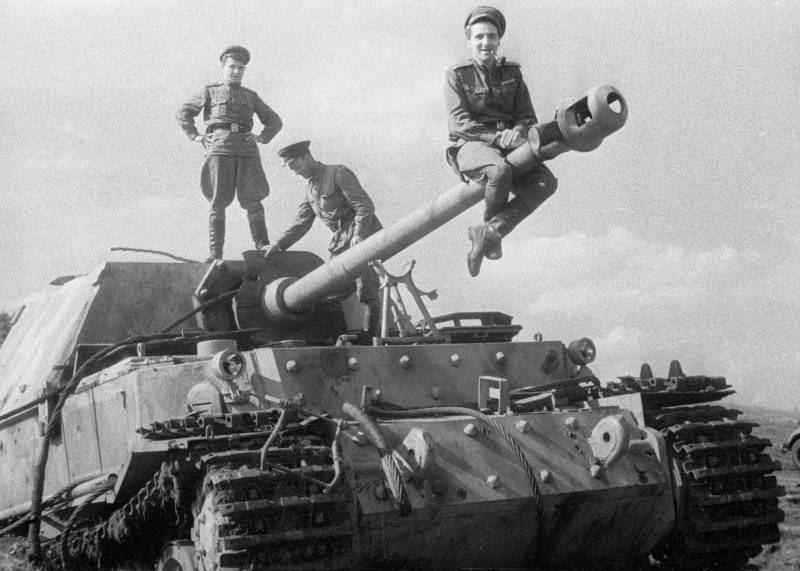
Correspondent K. M. Simonov on the trunk of the German self-propelled gun Ferdinand, lined up at the Kursk Bulge
Operation "Citadel"
The German military-political leadership has defined a strategy for the 1943 campaign of the year. The German headquarters of the High Command proposed that the main military efforts be moved from the Eastern Front to the Mediterranean Theater, in order to eliminate the threat of losing Italy and the Allied landings in Southern Europe. The General Staff of the Army held a different opinion. It was believed that it was necessary first of all to undermine the offensive capabilities of the Red Army, after which efforts could be focused on the struggle against the armed forces of Great Britain and the USA. The same point of view was shared by the commanders of the army groups on the Eastern Front and Adolf Hitler himself. It was taken as the basis for the final development of a strategic plan and planning of military operations for the spring - summer 1943 of the year.
The German military-political leadership decided to conduct one major offensive operation in one strategic direction. The choice fell on the so-called. Kursk salient, where the Germans hoped to defeat the Soviet armies of the Central and Voronezh fronts, creating a huge gap in the Soviet front and developing an offensive. According to the calculations of the German strategists, this should lead to a general change in the situation on the Eastern Front and the transfer of the strategic initiative into their hands.
The German command believed that after the end of winter and spring thaw the Red Army would again go on the offensive. Therefore, Hitler 13 March 1943 gave the order number 5 to pre-empt the enemy offensive in certain sectors of the front, in order to seize the initiative. In other places, the German troops were to "bleed the advancing enemy." The command of Army Group "South" was to form a strong tank grouping by the middle of April north of Kharkov, and the command of Army Group "Center" - a strike force in the Orel region. In addition, an attack on Leningrad was planned in July by forces of the Army Group North.
The Wehrmacht began to prepare the offensive, concentrating strong strike forces in the areas of Orel and Belgorod. The Germans planned to inflict powerful flank attacks on the Kursk bulge, which penetrated deep into the disposition of the German troops. From the north, troops of the Army Group Center (the Oryol bridgehead) hung over it, and from the South — the forces of Army Group South. The Germans planned to cut off the Kursk bulge under the foundation with concentric blows, surround and destroy the Soviet forces defending it.
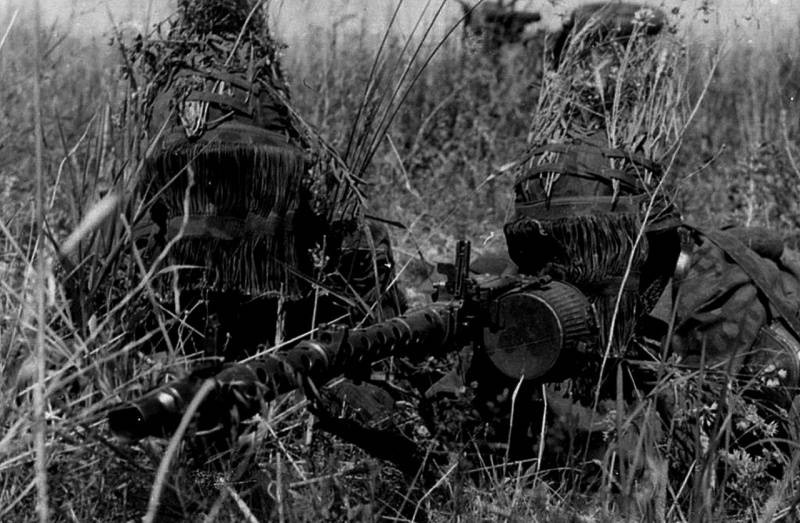
Disguised calculation machine gun MG-34, SS Panzer Division "Dead Head", near Kursk
15 On April 1943, the Wehrmacht’s headquarters gave operational order No. 6, which specified the tasks of the troops in the offensive operation, which was called the “Citadel”. The German stake was planning to go on the offensive as soon as the weather was good. This offensive was given decisive importance. It was supposed to lead to quick and decisive success, turning the tide on the Eastern Front in favor of the Third Reich. Therefore, the operation was prepared with great care and very thoroughly. In the direction of the main attacks, they planned to use selected units armed with the most modern weapons, attracted the best commanders and concentrated a large amount of ammunition. Active propaganda was carried out, each commander and soldier had to be imbued with the consciousness of the decisive significance of this operation.
The Germans pulled additional large forces into the area of the planned offensive by regrouping troops from other sectors of the front and transferring units from Germany, France and other regions. In total, for the offensive on the Kursk Bulge, the length of which was about 600 km, the Germans concentrated 50 divisions, including 16 tank and motorized. These troops included about 900 thousand soldiers and officers, up to 10 thousand guns and mortars, about 2700 tanks and self-propelled guns, and over 2 thousand aircraft. Particularly great importance was attached to the armored strike fist, which was supposed to crush the Soviet defense. The German command hoped for the success of the massive use of new technology - heavy tanks "tiger", medium tanks "panther" and heavy self-propelled guns like "ferdinand". In relation to the total number of troops on the Soviet-German front, the Germans concentrated 70% of tank and 30% of motorized divisions in the area of the Kursk ledge. The big role in the battle was to play aviation: Germans concentrated 60% of all combat aircraft that operated against the Red Army.
Thus, the Wehrmacht, having suffered serious losses in the winter campaign 1942-1943. and having smaller forces and resources than the Red Army, decided to deliver a powerful preemptive strike in one strategic direction, concentrating on it the elite units, most of the armored forces and aviation.
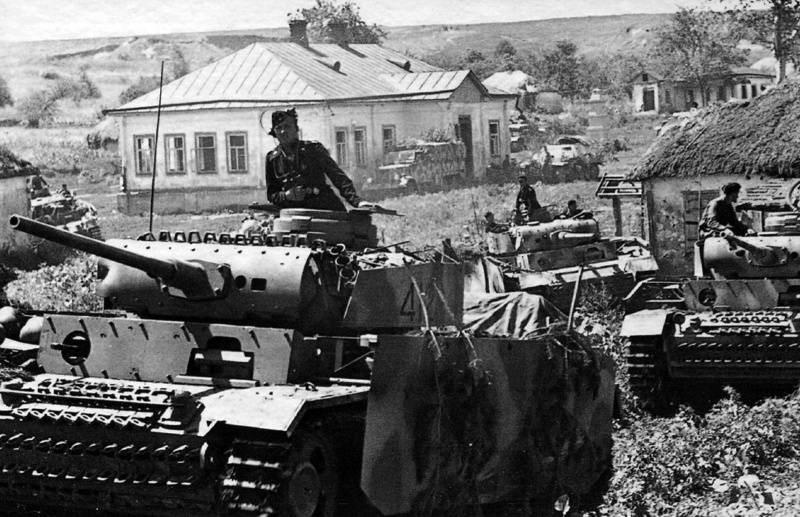
German shielded tanks Pz.Kpfw. III in a Soviet village before the start of Operation Citadel
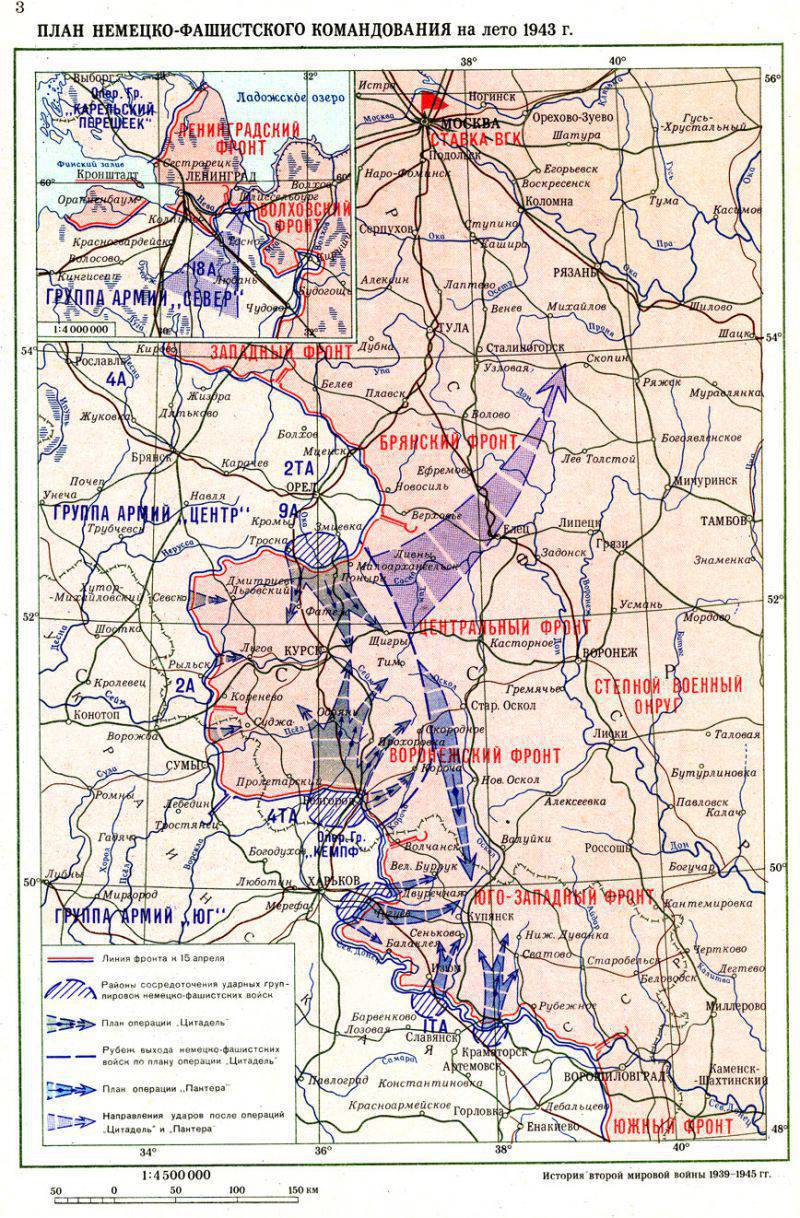
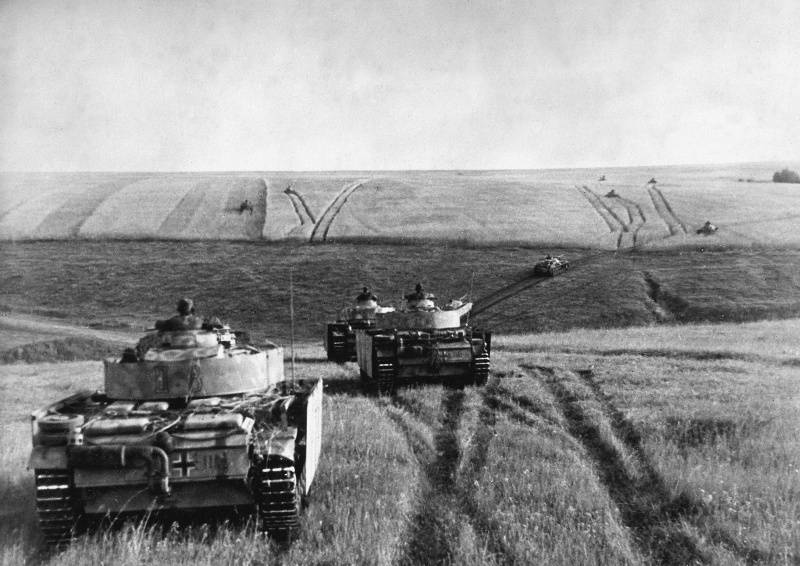
The movement of the 3 Panzer Grenadier Division of the SS "Totenkopf" on the Kursk Bulge
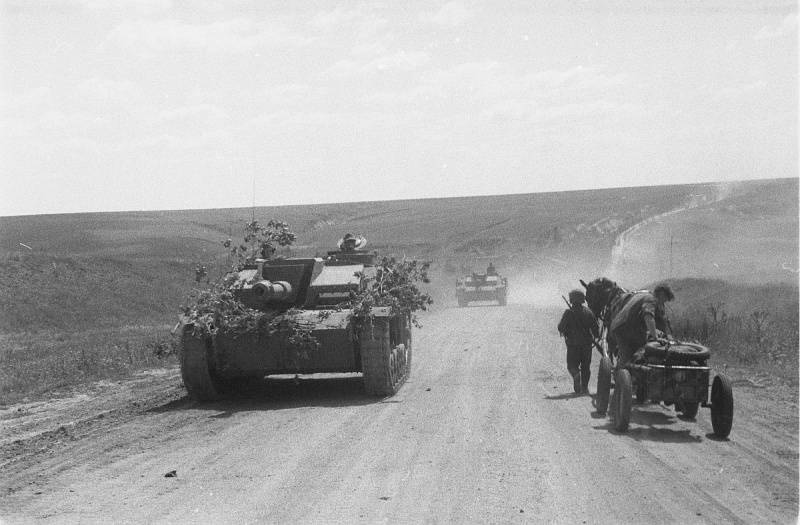
The unit of the German assault guns StuG III on the march along the road in the Belgorod region.
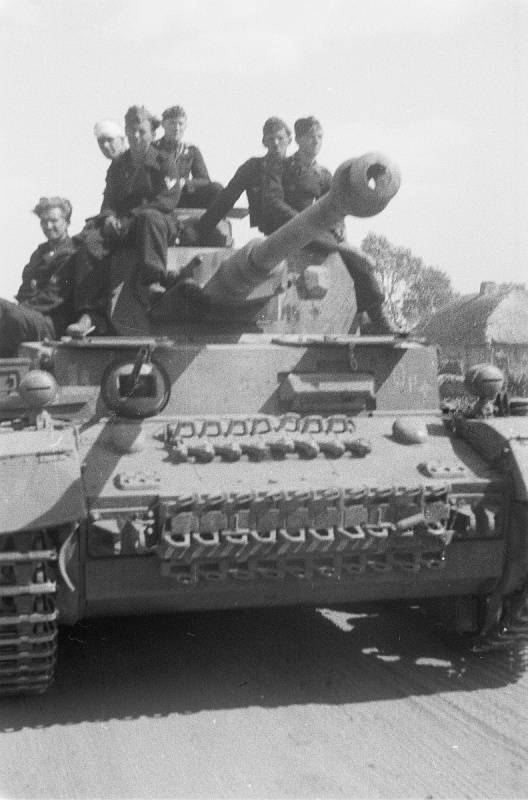
German medium tank Pz.Kpfw.IV Ausf. G 6 Tank Division of the 3 Tank Corps of the Kempf Army Group with armored tank crews in the Belgorod Region.
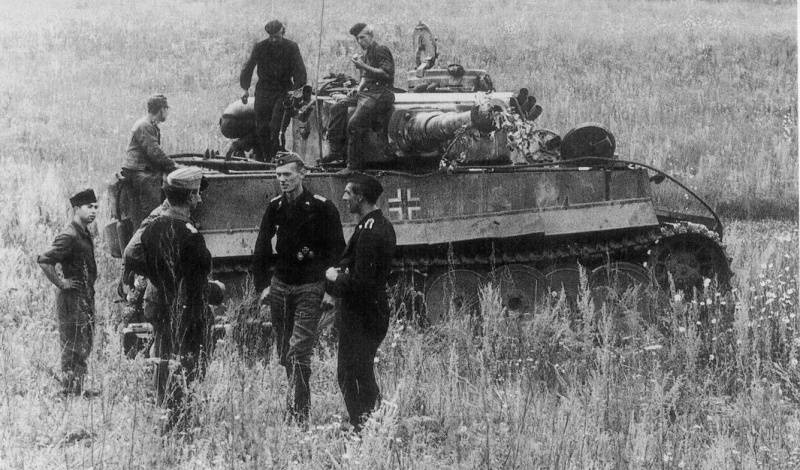
German tankers on a halt and a tank "Tiger" 503-th heavy tank battalion in the Kursk. Photo source: http://waralbum.ru/
Plans of the Soviet command
The Soviet side was also carefully preparing for a decisive battle. The Supreme High Command had the political will, large forces and means to complete a radical turn in the war, consolidating the success of the battle on the Volga. Immediately after the end of the winter campaign, at the end of March 1943, the Soviet General Headquarters began to think over the spring-summer campaign. First of all, it was necessary to determine the strategic plan of the enemy. The fronts were instructed to strengthen the defense and at the same time prepare for the offensive. Measures were taken to create strong reserves. The directive of the Supreme Commander from 5 of April gave instructions to create by April 30 a powerful Reserve Front, which was later renamed Stepnoye Okrug, and then Steppe Front.
Timely formed large reserves played a large role, first in the defensive, and then in the offensive operation. On the eve of the Battle of Kursk, the Soviet high command had huge reserves at the front: 9 army armies, 3 tank armies, 1 air army, 9 tank and mechanized corps, 63 rifle divisions. For example, the German command had all the 3 reserve infantry divisions on the Eastern Front. As a result, the troops of the Steppe Front could be used not only for counterattacks, but also for defense. The German command, in the course of the Battle of Kursk, had to withdraw troops from other sectors of the front, which weakened the general defense of the front.
A huge role was played by Soviet intelligence, which at the beginning of April, 1943, began to report on the forthcoming major enemy operation on the Kursk Bulge. It was established and the time of the enemy on the offensive. Similar data were obtained and the commanders of the Central and Voronezh fronts. This allowed the Soviet headquarters and the front command to take the most appropriate decisions. In addition, the British intelligence confirmed the British, who were able to intercept the plans of the German offensive in the Kursk area in the summer of 1943.
Soviet troops had superiority in manpower and equipment: 1,3 million people at the beginning of the operation, about 4,9 thousand tanks (with reserve), 26,5 thousand guns and mortars (with reserve), over 2,5 thousand aircraft. As a result, it was possible to preempt the enemy and organize a preventive offensive by the Soviet troops on the Kursk Bulge. Repeated exchange of views on this issue took place at the Headquarters and the General Staff. However, in the end, they accepted the idea of deliberate defense followed by a counteroffensive. On April 12, a meeting was held at Headquarters, where a preliminary decision was made on deliberate defense, concentrating the main efforts in the Kursk area, followed by a counteroffensive and a general offensive. The main attack in the course of the attack was planned in the direction of Kharkov, Poltava and Kiev. At the same time, the option of going on the offensive without a preliminary defense stage was envisaged if the enemy did not take active actions for a long time.
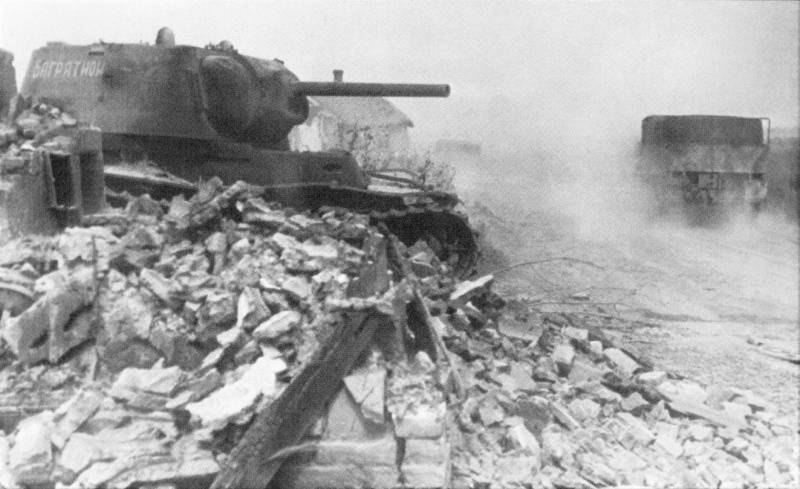
Soviet tank KV-1, with the personal name "Bagration", shot down in the village during Operation "Citadel"
The Soviet command, through the Intelligence Agency, the intelligence of the fronts and the Central Headquarters of the partisan movement, continued to closely monitor the enemy, the movement of his troops and reserves. In late May - early June 1943, when the enemy’s plan was finally confirmed, the Headquarters made a final decision on deliberate defense. The central front under the command of K. K. Rokossovsky was supposed to repel the enemy's strike from the area south of Orel, the Voronezh Front of NF Vatutin — from the area of Belgorod. They were propped up by the Steppe Front, I. S. Konev. The activities of the fronts were coordinated by representatives of the Supreme Command Headquarters Marshals of the Soviet Union G. K. Zhukov and A. M. Vasilevsky. Offensive actions were planned: on the Orel direction - by the forces of the left wing of the Western Front, Bryansk and Central Fronts (operation “Kutuzov”), on the Belgorod-Kharkov direction - by the forces of the Voronezh, Steppe Fronts and the right wing of the Southwestern Front (operation “Rumyantsev”) .
Thus, the supreme Soviet command revealed the plans of the enemy and decided to bleed the enemy with a powerful deliberate defense, and then go on the counteroffensive and inflict a decisive defeat on the German troops. Further developments showed the correctness of the Soviet strategy. Although a number of miscalculations led to great losses of the Soviet troops.
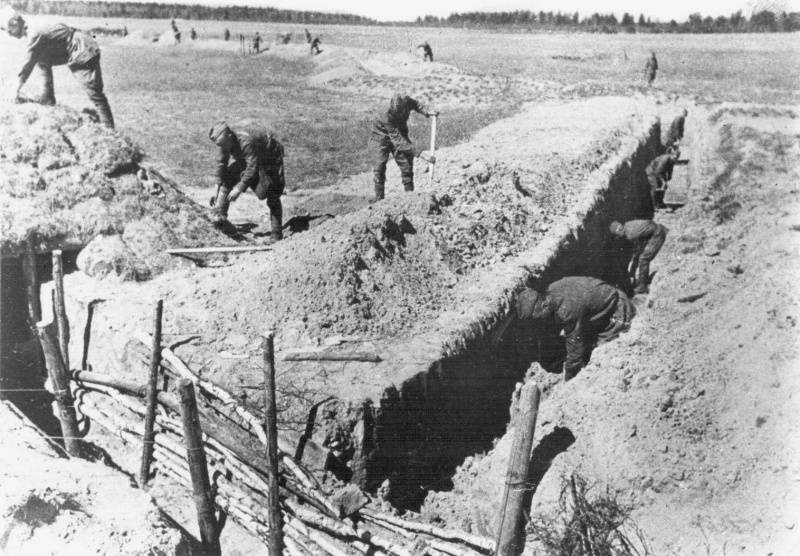
Construction of fortifications on the Kursk Bulge
Guerrilla formations played an important role in the Battle of Kursk. The guerrillas not only collected intelligence, but also violated enemy communications and conducted mass sabotage. As a result, by the summer of 1943, in the rear of the Army Group Center, the partisans of Belarus bound more than 80 to thousands of enemy soldiers, Smolensk - about 60 thousand, Bryansk - over 50 thousand. Thus, the Hitlerite command had to divert large forces to fight the partisans and protect communications.
A great deal of work has been done in the organization of defense orders. During April-June, only Rokossovsky's troops dug out more than 5 thousand km of trenches and communication lines, installed up to 400 thousand mines and land mines. Our troops prepared anti-tank areas with strong strong points as deep as 30-35 km. On the Voronezh front of Vatutin, defense in depth was also created.
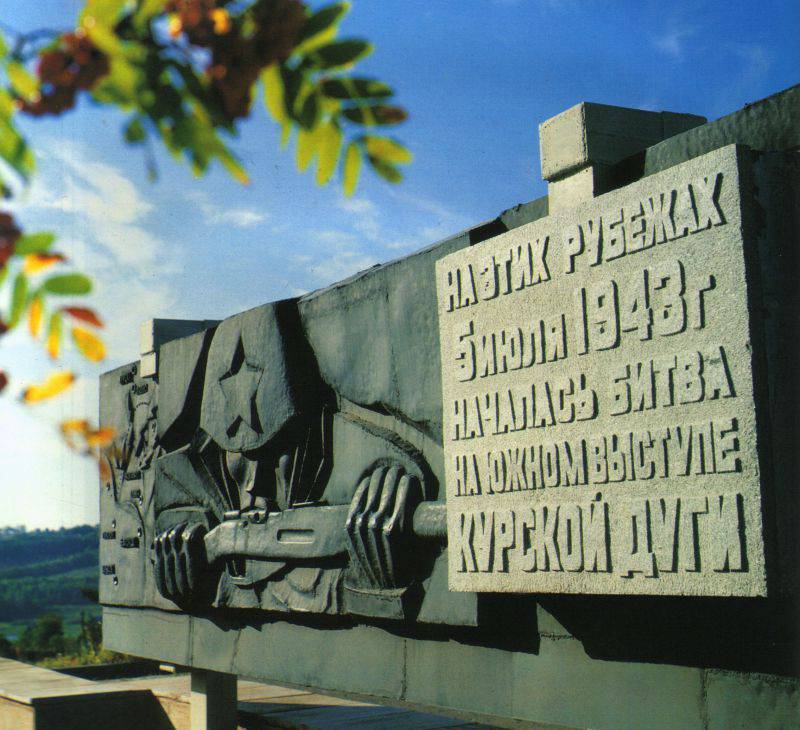
Memorial "The beginning of the Battle of Kursk on the southern ledge." Belgorod region
Wehrmacht offensive
Hitler, trying to give the troops as many tanks and other weapons as possible, several times postponed the onset of the offensive. Soviet intelligence several times reported the start date of the German operation. 2 July 1943. The headquarters sent a third warning to the troops that the enemy was attacking during the period 3-6 July. The captured “tongues” confirmed that the German troops would launch an offensive in the early morning of July 5. Before dawn, in 2 hours 20 min., Soviet artillery attacked enemy concentration areas. The grand battle did not start as the Germans planned, but it was impossible to stop it.
5 July at 5 hour. 30 min. and in 6 hour. In the morning, the troops of the “Center” and “South” groups von Kluge and Manstein launched an offensive. The breakthrough of the defense of the Soviet troops was the first step towards the implementation of the plan of the German High Command. Supported by strong artillery, mortar fire and air attacks, German tank wedges attacked the Soviet defensive lines. At the cost of heavy casualties, the German forces managed in two days to penetrate the 10 km into the battle formations of the Central Front. However, the Germans were unable to break through the second lane of the 13 Army’s defense, which eventually led to the breakdown of the entire Oryol grouping. 7-8 July, the Germans continued fierce attacks, but did not achieve serious success. The following days also did not bring success to the Wehrmacht. July 12 defensive battle in the Central Front was completed. In six days of fierce battle, the Germans were able to penetrate into the defense of the Central Front in the zone up to 10 km and in depth - up to 12 km. Having exhausted all forces and resources, the Germans stopped the offensive and went over to the defensive.
The situation was similar in the south, although here the Germans achieved great success. German troops penetrated into the location of the Voronezh Front to a depth of 35 km. They could not achieve more. There were clashes of large masses of tanks (the battle of Prokhorovka). The enemy strike was repelled by the introduction of additional forces from the Steppe and Southwestern fronts. 16 July, the Germans stopped the attacks and began to withdraw troops in the area of Belgorod. July 17 began to withdraw the main forces of the German group. On July 18, the troops of the Voronezh and Steppe Fronts began the pursuit and on July 23 restored the situation that was before the enemy went over to the offensive.
Soviet offensive
After bleeding the enemy’s main attack forces and depleting its reserves, our troops launched a counteroffensive. In accordance with the plan of Operation Kutuzov, which provided for offensive operations in the Oryol sector, a strike against the group of the Army Group Center was made by the forces of the Central, Bryansk and Left Wings of the Western Front. Colonel General MM Popov commanded the Bryansk Front, Colonel General V. D. Sokolovsky the West Front. On July 12, the Bryansk Front was the first to launch an offensive — 3, 61, and 63, under the command of generals A.V. Gorbatov, P.A. Belova, V.Ya. Kolpakchi, and 11-I Guards Army of the Western Front, commanded by I. H. Baghramyan.
In the very first days of the offensive, the deeply echeloned and well-equipped engineering defense of the enemy was broken. Particularly successful was the 11-I Guards Army, which was operating from the Kozelsk region in the general direction of Hotynets. At the first stage of the operation, the guardsmen of Baghramian, interacting with the 61 army, were to break the Wehrmacht’s Balkhov grouping, covering Orlovsky ledge from the north, with counter blows. On the second day of the offensive, the army of Bagramyan broke through the enemy defenses to a depth of 25 km, and the troops of the 61-th army penetrated into the defense of the enemy at 3-7 km. The 3 and 63 armies, which were advancing towards Eagle, advanced to 13-14 km by the end of 15 July.
The defense of the enemy on the Oryol ledge immediately found itself in a crisis situation. In the operational reports of the German 2 tank and 9 armies, it was noted that the center of combat operations had moved into the band of the 2 tank army and the crisis was developing with incredible speed. The command of Army Group "Center" was forced to urgently withdraw 7 divisions from the southern segment of the Orlovsky protrusion and transfer them to areas where Soviet troops threatened to break through. However, the enemy could not eliminate the breakthrough.
July 14 11-I Guards and 61-I armies approached Bolkhov from the west and east, and 3-I and 63-I armies continued to rush to the Eagle. The German command continued to reinforce the 2 Tank Army, hastily transferring troops from the neighboring 9 Army and other sectors of the front. The Soviet Headquarters discovered the rearrangement of the enemy forces and the Headquarters betrayed the Bryansk Front from its reserve 3 Guards Tank Army under the command of General P. S. Rybalko, who joined the battle of Orel in July. Also in the 20-th Guards Army strip on the left wing of the Western Front arrived the 11-I army of General I. I. Fedyuninsky, the 11-I tank army of V.M. Badanov and the 4-th Guards cavalry corps of V.V. Reserves with the move involved in the battle.
Bolkhovskaya grouping of the enemy was broken. On July 26, German troops were forced to leave the Oryol bridgehead and begin a retreat to the Hagen position (east of Bryansk). July 29, our troops liberated Bolkhov, August 5 - Orel, August 11 - Hotynets, August 15 - Karachev. By August 18, Soviet troops approached the enemy defensive line east of Bryansk. With the defeat of the Oryol group, the plans of the German command to use the Oryol bridgehead to strike eastward collapsed. The counteroffensive began to develop into a general offensive by the Soviet troops.
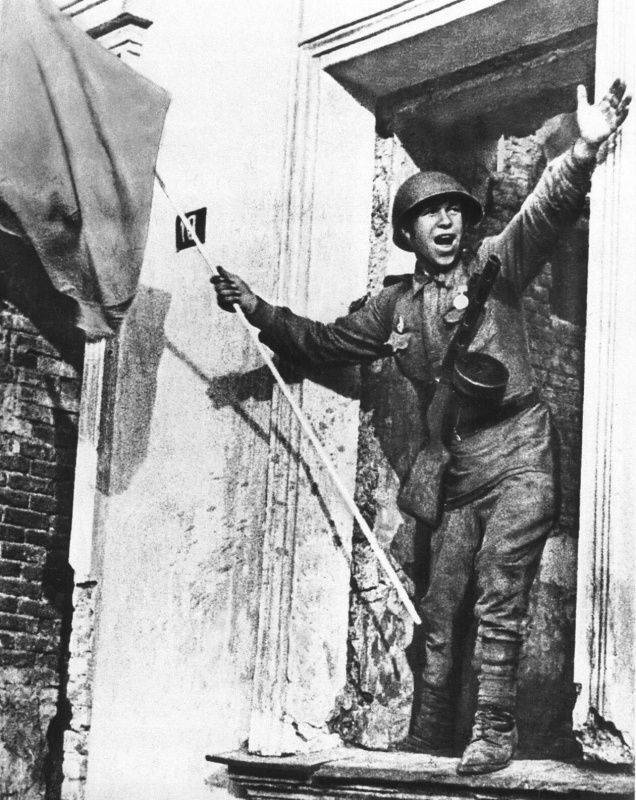
Soviet soldier with a banner in the liberated Orel
The central front under the command of K. K. Rokossovsky by the troops of their right wing — the 48, 13, and 70 armies — went on the offensive on July 15, acting in the general direction on Kromy. Significantly bloodless in previous battles, these troops advanced slowly, overcoming the strong defenses of the enemy. As Rokossovsky recalled: “The troops had to gnaw one position after another, pushing the Nazis, who used mobile defenses. This was expressed in the fact that while one part of his forces was defending, the other in the rear of the defenders occupied a new position, which was removed from the first on 5-8 km. At the same time, the enemy widely used counterattacks with tank forces, as well as maneuvering forces and means along internal lines. ” Thus, knocking down the enemy from the fortified lines and beating off fierce counterattacks, developing an offensive north-west in the direction of Krom, the forces of the Central Front advanced to 30 July to a depth of 40 km.
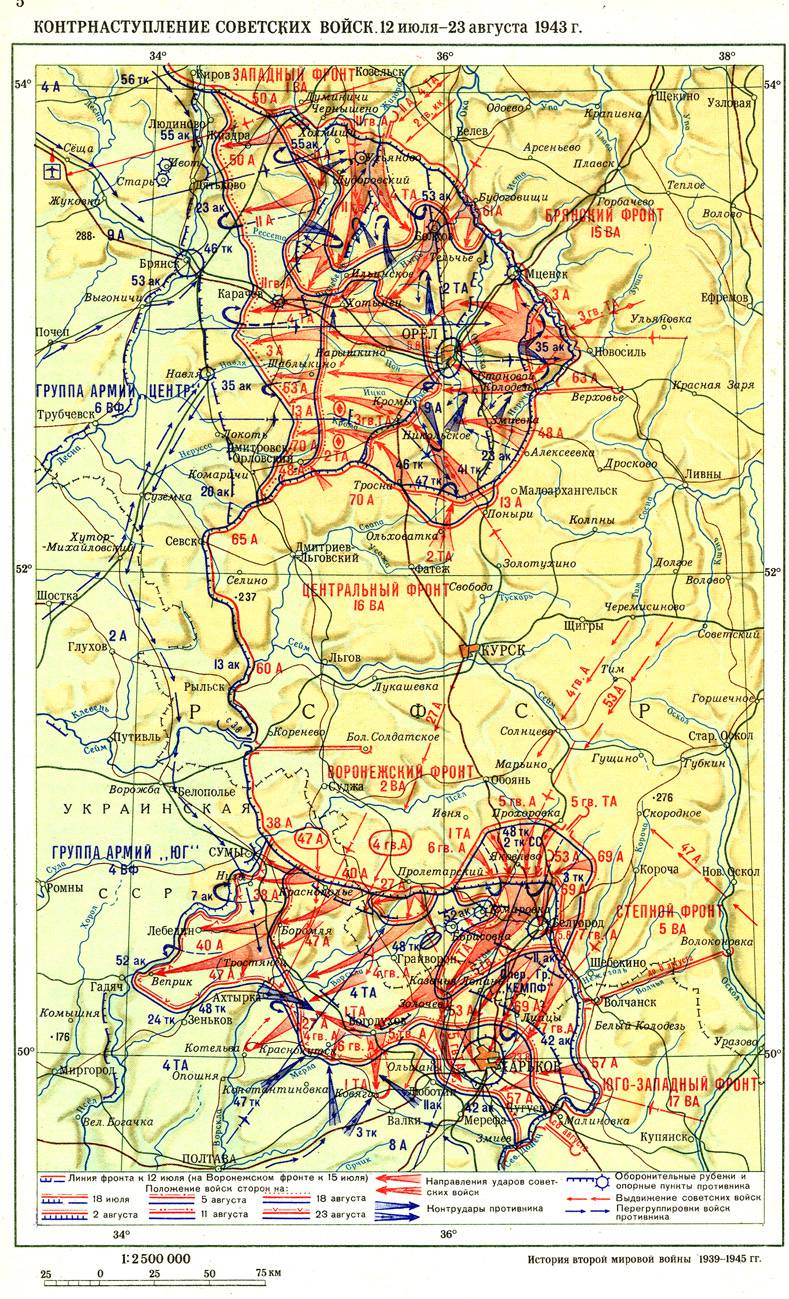
Troops of the Voronezh and Steppe Fronts, under the command of N. F. Vatutin and I. S. Konev, interacting with the South-Western Front R. Ya. Malinovsky, attacked the Belgorod-Kharkov sector. The Voronezh Front during the defensive operation withstood the strongest onslaught of the enemy, suffered heavy losses, so it was reinforced by the army of the Steppe Front. 23 July, moving away to strong defensive lines north of Belgorod, the Wehrmacht took up defense and prepared to repel the attacks of the Soviet troops. However, the enemy could not hold the onslaught of the Red Army. The troops of Vatutin and Konev delivered the main blow to the adjacent flanks of the fronts from the Belgorod region in the general direction of Bogoduhov, Valka, Novaya Vodolaga, bypassing Kharkov from the west. The 57 Army of the Southwestern Front struck, bypassing Kharkov from the southwest. All actions were envisaged by the Rumyantsev plan.
August 3 Voronezh and Steppe fronts after a powerful artillery and aviation training went on the offensive. The troops of the 5 and 6 guards armies operating in the first echelon of the Voronezh Front broke through the defenses of the enemy. The 1-i and 5-I guards tank armies, entered into the breakthrough with the support of the infantry, completed the breakthrough of the tactical defense zone of the Wehrmacht and advanced on 25-26 km. On the second day, the offensive continued to develop successfully. In the center of the front line, the 27 and 40 armies attacked the main attack force of the front. The troops of the Steppe Front — the 53, 69 and 7 Guards armies and the 1 mechanized corps — rushed to Belgorod.
5 August our troops liberated Belgorod. In the evening of August 5 in Moscow, for the first time, an artillery salute was given in honor of the troops that liberated Orel and Belgorod. It was the first salute during the Great Patriotic War, celebrating the victory of the Soviet troops. 7 August Soviet troops liberated Bogoduhov. By the end of August 11, the troops of the Voronezh Front cut the Kharkov-Poltava railway. The troops of the Steppe Front closely approached the external defensive bypass of Kharkov. The German command, in order to save the Kharkov grouping from the encirclement, threw into battle the reserves transferred from Donbass. The Germans concentrated 4 infantry and 7 armored and motorized divisions that had tanks before 600 south of Akhtyrka and south of Bohodukhiv. But the counterattacks undertaken by the Wehrmacht in the 11 — 17 period of August against the troops of the Voronezh Front in the area of Bogodukhov and then in the Akhtyrka area did not lead to decisive success. Counterstrokes of tank divisions along the left wing and the center of the Voronezh front were hit by the nazis who were able to stop the forces of the 6 Guards and 1 Tank armies that had already been drained of blood. However, Vatutin threw the 5 th Guards Tank Army into battle. The 40 and 27 armies continued to move, the 38 armies launched an attack. The command of the Voronezh Front, on the right flank, threw into battle its reserve — General P. P. Korzun's 47 Army. In the area of Akhtyrka, the reserve of the Headquarters was concentrated - GI Kulik's 4 Guards Army. Violent battles in the area ended with the defeat of the Nazis. German troops were forced to stop the attacks and go on the defensive.
The troops of the Steppe Front developed an offensive against Kharkov. As Konev recalled: “On the approaches to the city, the enemy created strong defense lines, and around the city, a fortified line with a developed network of strong points, in some places with reinforced concrete pillboxes, dug-in tanks and barriers. The city itself was adapted for all-round defense. To retain Kharkov, the Hitlerite command transferred the best tank divisions here. Hitler demanded to keep Kharkov at all costs, pointing out to Manstein that the capture of the city by Soviet troops poses the threat of losing Donbass. ”
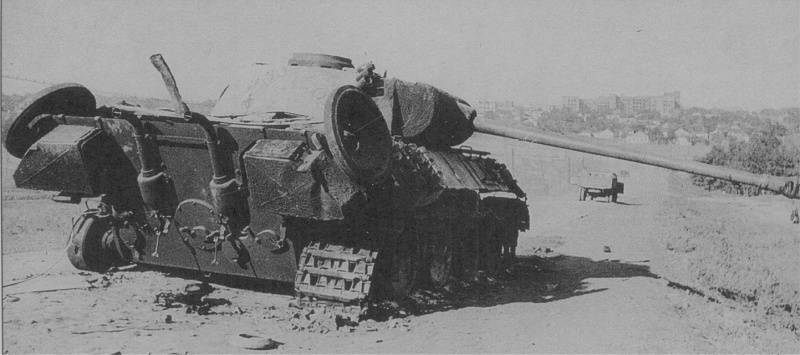
German tank Pz.Kpfw. V "Panther", padded by the calculation of the senior sergeant Guard Parfenov. The outskirts of Kharkov, August 1943 year
23 August after stubborn fighting, Soviet troops completely liberated Kharkov from the Nazis. Much of the enemy grouping was destroyed. The remnants of Hitler's troops retreated. With the capture of Kharkov, the grand battle at the Kursk Bulge was completed. Moscow saluted the liberators of Kharkov 20 with volleys of 224 guns.
Thus, during the offensive on the Belgorod-Kharkov direction, our troops advanced 140 km and hung over the entire southern wing of the German front, taking an advantageous position to go to a general offensive in order to liberate Left-Bank Ukraine and reach the line of the Dnieper River.
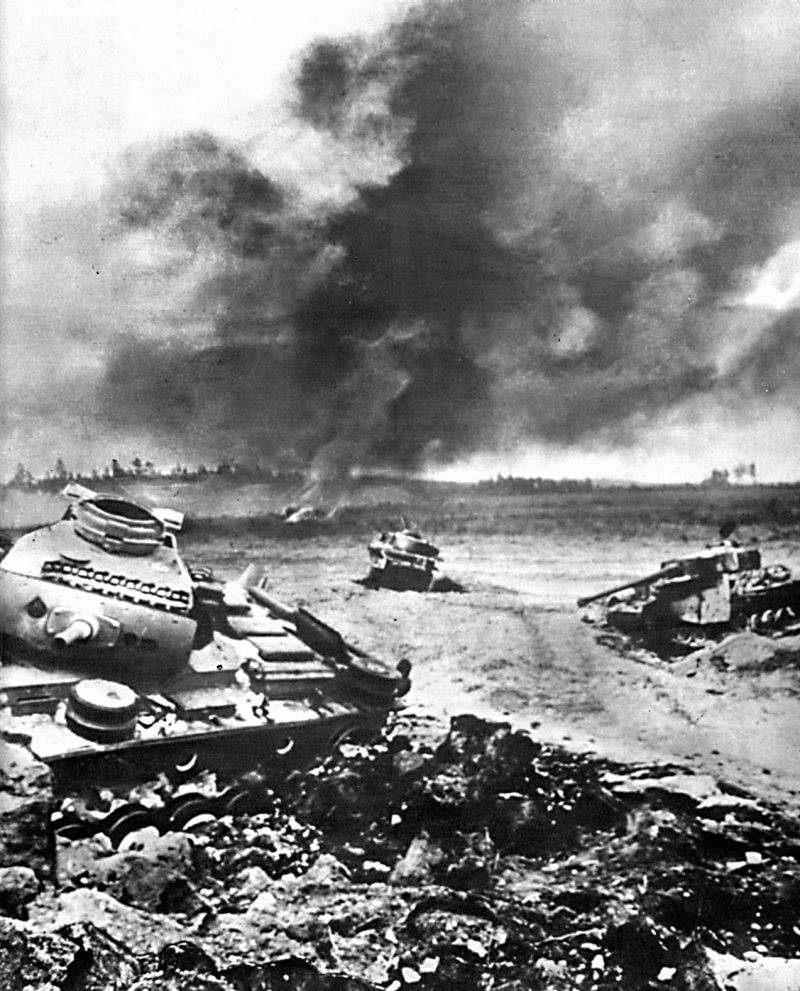
On the Belgorod-Kharkov direction. Broken enemy technology after a raid by Soviet aviation
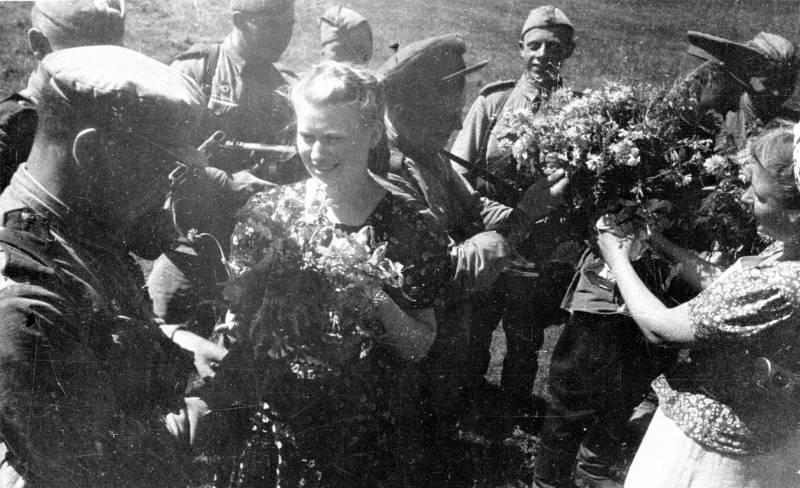
The population of the liberated Belgorod meets the fighters and commanders of the Red Army
Results
The Battle of Kursk ended with a complete victory for the Red Army and led to a final radical change in the Great Patriotic War and the entire Second World War. The German command lost its strategic initiative on the Eastern Front. German troops moved to a strategic defense. It was not only the German offensive that failed, the enemy defense was broken through, the Soviet troops launched a general offensive. The Soviet Air Force in this battle finally won air supremacy.
Field Marshal Manstein assessed the outcome of Operation Citadel: “It was the last attempt to keep our initiative in the East; with its failure, equivalent to failure, the initiative finally passed to the Soviet side. Therefore, Operation Citadel is a decisive turning point in the war on the Eastern Front. ”
As a result of the defeat of significant forces of the Wehrmacht on the Soviet-German front, more favorable conditions were created for the deployment of the actions of the US-British troops in Italy, the beginning of the disintegration of the fascist bloc - the Mussolini regime collapsed, and Italy withdrew from the war on the German side. Under the influence of the victories of the Red Army, the scale of the resistance movement in the countries occupied by the German forces increased, and the authority of the USSR as the leading force of the anti-Hitler coalition became stronger.
The Battle of Kursk was one of the biggest battles of the Second World War. On both sides, more than 4 million people were involved in it, over 69 thousand guns and mortars, more than 13 thousand tanks and SPGs, up to 12 thousand aircraft. In the Battle of Kursk, the Wehrmacht 30 divisions, including the 7 tank divisions, were defeated. The German army lost 500 thousand people, up to 1500 tanks and SAU, 3000 guns and about 1700 aircraft. The losses of the Red Army were also very large: more than 860 thousand people, more than 6 thousand tanks and self-propelled guns, more than 1600 aircraft.
In the Battle of Kursk, Soviet soldiers showed courage, resilience and mass heroism. Over 100, thousands of people were awarded orders and medals, 231 people were awarded the title Hero of the Soviet Union, 132 formations and units received the Guards rank, 26 awarded the honorary titles of the Orel, Belgorod, Kharkov and Karachevsky.
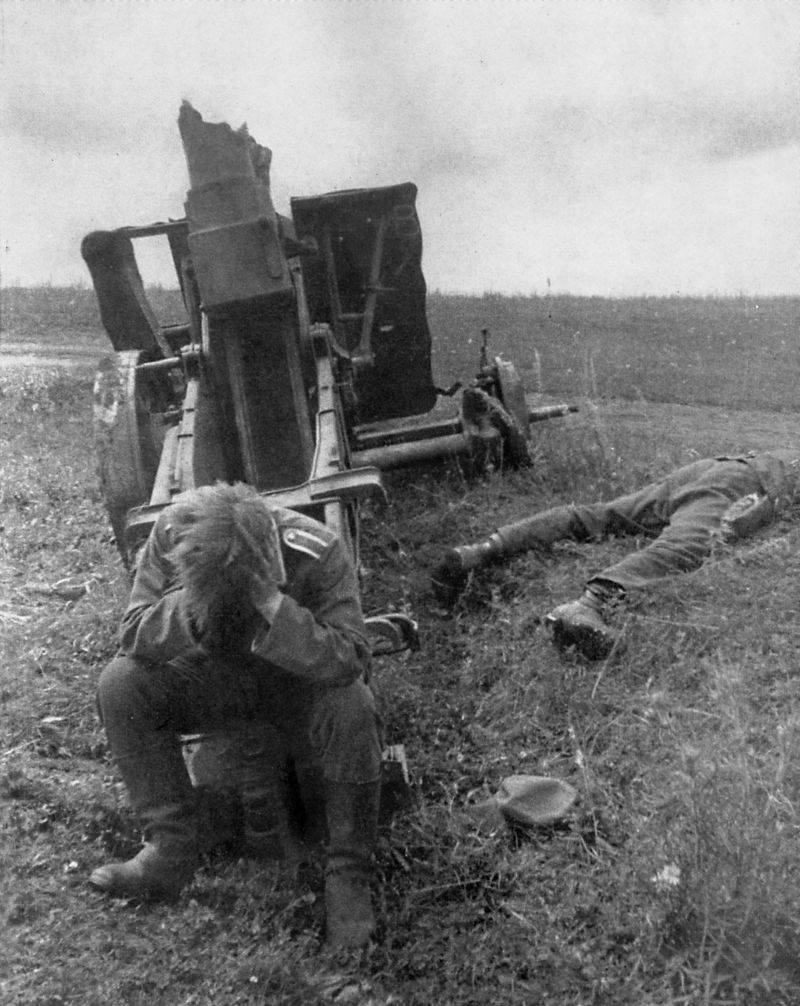
The collapse of hope. German soldier on Prokhorovsky field
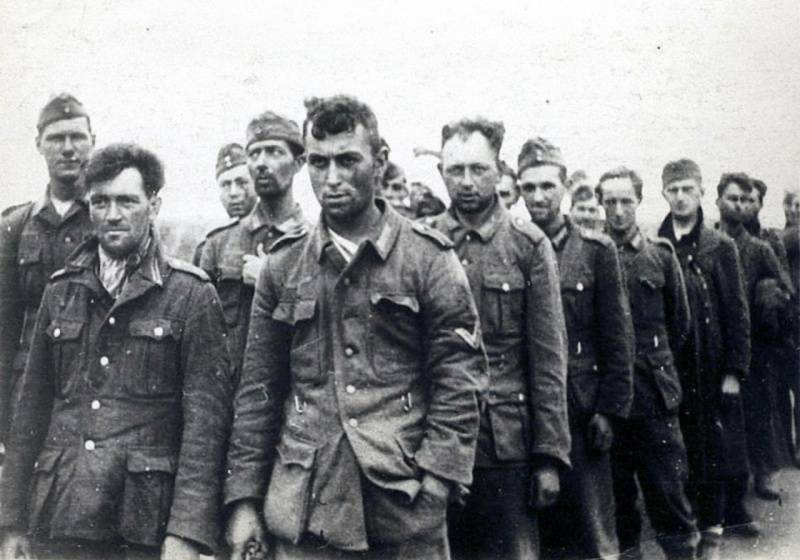
Column of German prisoners of war captured in battles on Oryol direction, 1943
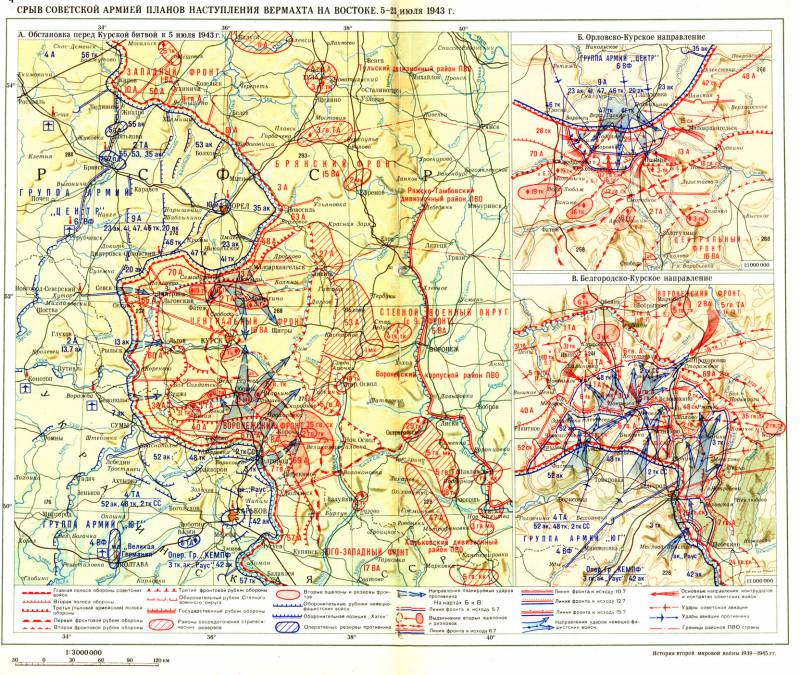
Information